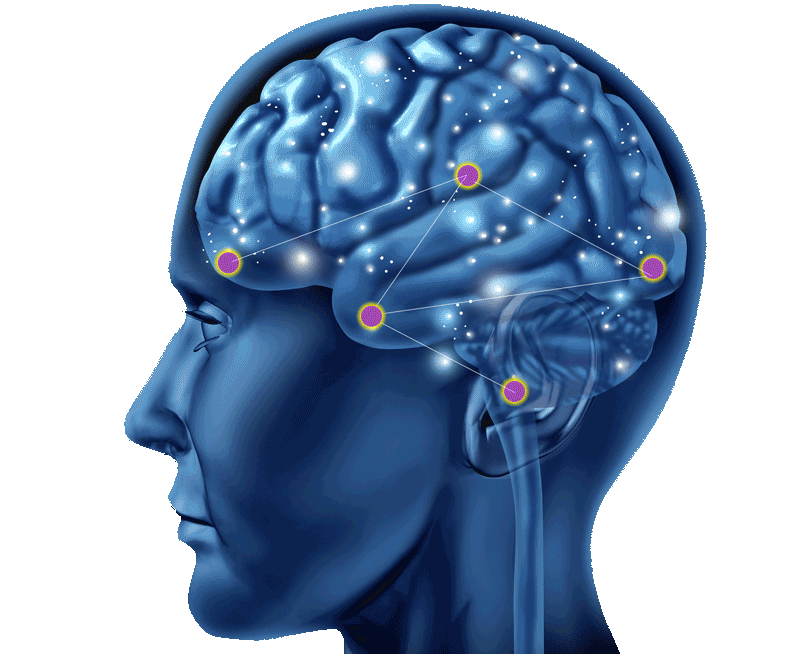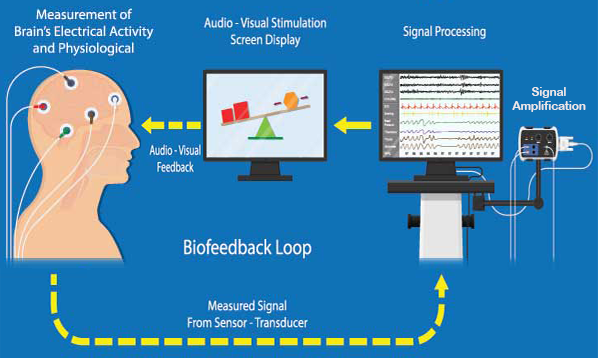About Neurofeedback
First, the “non-technical” explanation
Neurofeedback has been in practice since the 1950s. The principle is a very simple one.
All brain function – all thinking – generates brainwaves, and there are many “kinds” of brainwaves. It shouldn’t be surprising that brainwave patterns look quite different from one to the other, depending on what you’re doing in the moment.
As an example, Delta brainwaves are “slow” brainwaves that are generated in deepest mediation and dreamless sleep, whereas Beta brainwaves are “fast” and dominate our normal awake state. Beta is present when we are alert, attentive, engaged in problem solving, judgment, decision making, or focused on mental activity.
The above is an example of just two of the many different brainwaves, but you may wonder, “Why do these different brainwave patterns matter?”
When our brainwaves are out of balance, there will be problems in our emotional or neuro-physical health. For instance, over-arousal in certain brain areas is linked with anxiety disorders , sleep problems, nightmares hyper-vigilance, impulsive behavior, anger/aggression, agitated depression, chronic nerve pain and spasticity.
Under-arousal leads to some types of depressions, attention deficit, chronic pain and insomnia. And a combination of under-arousal and over-arousal is seen in cases of anxiety, depression and ADHD.

Instabilities in brain rhythms correlate with tics, obsessive-compulsive disorder, aggressive behavior, rage, bruxism, panic attacks, bipolar disorder, migraines, narcolepsy, epilepsy, sleep apnea, vertigo, tinnitus, anorexia/bulimia, PMT, diabetes, hypoglycaemia and explosive behavior.

The Good News
The good news is you can alter your brainwaves. Conventional medicine typically prescribes medication for this, but brainwave training (Neurofeedback) is a preferred treatment for many people, since many medications can have unwanted side-effects, or simply aren’t working as hoped.
By placing sensors on the patient’s head, we can see the brainwave patterns on a computer monitor. And by monitoring those brainwaves as the patient, for example, watches a movie – we can interrupt the movie when the brain starts behaving out of balance, and then resume the movie when the brain corrects this imbalance.
Through repetition of this and other practices, the brain learns to balance itself in ways it never could before. And if this sounds familiar, it should – repetition is how the brain learns most new things. The more you repeat a new behavior, the more it replaces the old behavior, as neural pathways get deeper and deeper with repetition. But before Neurofeedback, little was known about how to interpret and alter brainwave patterns in this way (without medication).
The Scientific Explanation

For those of you interested in reading a more technical explanation, you’ll find everything you need here at the National Library of Medicine. (an official website of the US Government).
The Process
- Contact Us
Is NeuroFeedback right for you or your loved one?
You have questions. We do too. Your first step is an easy one – we have a chat.
When you’re ready, reach out via our Contact page (free of course).


2. Assess
Using QEEG Brain Mapping, we create a treatment plan that addresses your particular situation and needs.
This process allows us to create the treatment plan for the sessions that you will attend going forward.
3. Sessions
Each session typically takes about 45 minutes, though it can vary (for instance, younger children’s sessions might be shorter).
A session involves sitting comfortably, watching a computer monitor with your technician.
How many sessions will be needed? Check out the FAQs below.

Frequently Asked Questions
What different conditions does Neurofeedback help with?
*There are many more conditions helped by Neurofeedback that are being discovered each year. If the condition you are interested in is not listed above, please feel free to ask us.
Is Neurofeedback safe?
Any potential negative side effects are very rare, minor and brief. They include fatigue or slight dizziness after a treatment. Feel free to discuss this with your technician.
Are improvements permanent?
Is Neurofeedback covered by insurance?
*If insurance is indeed your only payment option, please contact your provider before you reach out to us.
How much will it cost?
- After reading all FAQs, a first meeting (in person or by phone) is free.
- If you choose to go ahead, the first session and QEEG will cost approximately $700.
- Treatments come next and cost about $2,650 for 20 sessions. *The ideal number of sessions is generally about 40, but this should be discussed for your situation.
